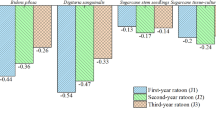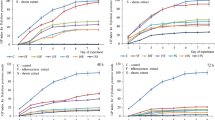Abstract
Field observations on undisturbed stands of sour orange revealed thatCynodon dactylon, Chenopodium album, Avena sativa, andAmaranthus retroflexus were not able to grow normally and complete their life cycles under its canopies, although the same species grow well under adjacent trees of date palm. Investigations revealed that the failure of the test species to grow normally under sour orange was not due to competition for light, moisture and minerals or to differences in soil texture or pH. Soil under sour orange trees drastically reduced seed germination and/or seedling growth of test species. Aqueous extracts, decaying materials, and volatile compounds of senescent and nonsenescent sour orange leaves were found to inhibit seed germination and/or seedling growth of test species. Therefore, allelopathy appeared to be the basic factor responsible for the reduction in plant growth with competition propably accentuating its effects.
Similar content being viewed by others
References
Al-Naib, F.A., andRice, E.L. 1971. Allelopathic effects ofPlatanus occidentalis.Bull. Torrey Bot. Club 98:75–82.
Anderson, J.V., andHarris, W. 1967. Determination of organic carbonates in soil.Soil Sci. Am. Proc. 31:341–343.
Bouyoucos, G. 1936. Directions for making mechanical analysis of soils by hydrometer method.Soil Sci. 41:255–229.
Bremner, J.M. 1965. Total nitrogen, pp. 1149–1178,in Methods of Soil Analysis, Part 2. C.A. Black ed. American Society for Agronomy, Inc., Madison, Wisconsin.
Del-Moral, R., andGates, R.G. 1971. Allelopathic potential of dominant vegetation of western Washington.Ecology 52:1030–1037.
Del-Moral, R., andMuller, C.H. 1970. The allelopathic effects ofEucalyptus camaldulensis.Am. Midl. Nat. 83:254–282.
Grove, C.R., andAnderson, J.F. 1981. Allelopathic effects ofArtemisia tridentata leaves on germination and growth of two grass species.Am. Midl. Nat. 106:73–79.
Hoagland, D.R., andArnon, D.I. 1950. The water culture method for growing plants without soil.Calif. Agric. Exp. Stn. Cir. 347.
Horsley, S.B. 1977. Allelopathic interference among plants. II. Physiological modes of action, pp. 93–136,in H.E. Wilcox andA.F. Hamer (eds.). Proceedings of the Fourth North American Forest Biology Workshop. School of Continuing Education. College of Environmental Science and Forestry, Syracuse, New York.
Lodhi, M.A.K. 1975. Allelopathic effects of hackberry in a bottomland forest community.J. Chem. Ecol. 1:171–182.
Olsen, S.R.,Colec, V.,Watanabe, F.S., andDean, L.A., 1954. Estimation of available p in soils by extraction with sodium bicarbonate.U.S. Dept. Agric. Cir. 939.
Piper, C.S. 1942. Soil and Plant Analysis. University of Adelaide, Adelaide, Australia, 368 pp.
Rice, E.L. 1972. Allelopathic effects ofAndropogon virginicus and its persistence in old fields.Am. J. Bot. 59:752–755.
Rice, E.L. 1974. Allelopathy. Academic Press, New York.
Rice, E.L. 1979. Allelopathy. An update.Bot. Rev. 45:15–109.
Author information
Authors and Affiliations
Rights and permissions
About this article
Cite this article
Alssadawi, I.S., AlRubeaa, A.J. Allelopathic effects ofCitrus aurantium L.. J Chem Ecol 11, 1515–1525 (1985). https://doi.org/10.1007/BF01012197
Received:
Accepted:
Issue Date:
DOI: https://doi.org/10.1007/BF01012197




